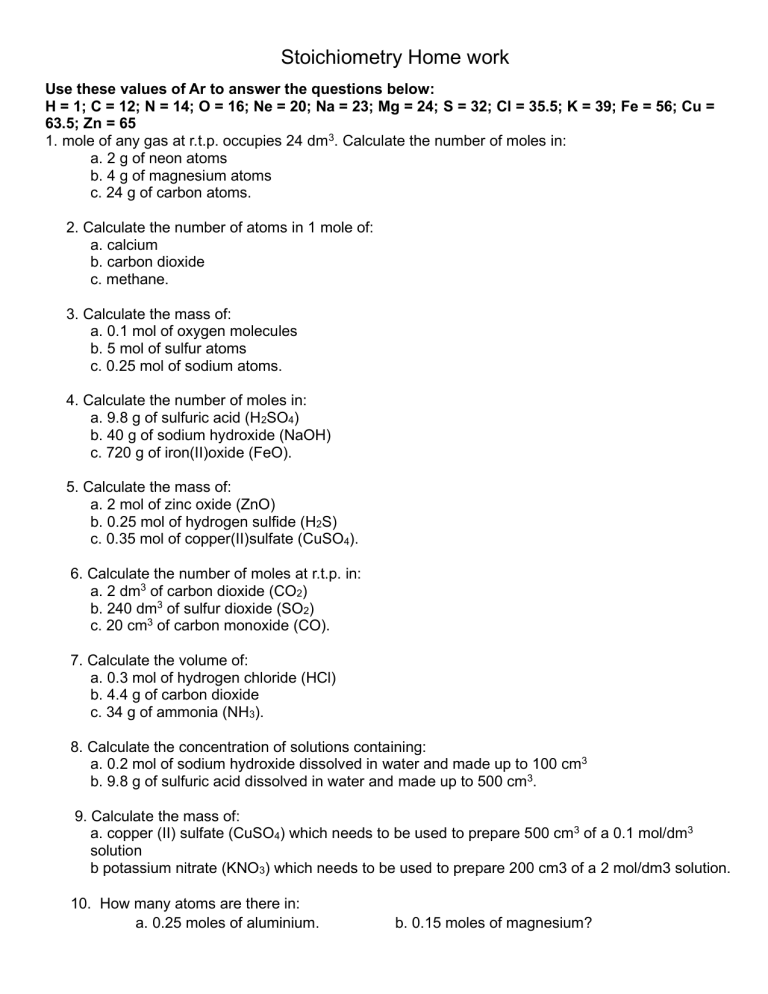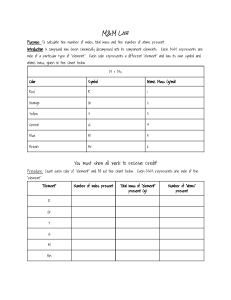
Stoichiometry Home work Use these values of Ar to answer the questions below: H = 1; C = 12; N = 14; O = 16; Ne = 20; Na = 23; Mg = 24; S = 32; Cl = 35.5; K = 39; Fe = 56; Cu = 63.5; Zn = 65 1. mole of any gas at r.t.p. occupies 24 dm3. Calculate the number of moles in: a. 2 g of neon atoms b. 4 g of magnesium atoms c. 24 g of carbon atoms. 2. Calculate the number of atoms in 1 mole of: a. calcium b. carbon dioxide c. methane. 3. Calculate the mass of: a. 0.1 mol of oxygen molecules b. 5 mol of sulfur atoms c. 0.25 mol of sodium atoms. 4. Calculate the number of moles in: a. 9.8 g of sulfuric acid (H2SO4) b. 40 g of sodium hydroxide (NaOH) c. 720 g of iron(II)oxide (FeO). 5. Calculate the mass of: a. 2 mol of zinc oxide (ZnO) b. 0.25 mol of hydrogen sulfide (H2S) c. 0.35 mol of copper(II)sulfate (CuSO4). 6. Calculate the number of moles at r.t.p. in: a. 2 dm3 of carbon dioxide (CO2) b. 240 dm3 of sulfur dioxide (SO2) c. 20 cm3 of carbon monoxide (CO). 7. Calculate the volume of: a. 0.3 mol of hydrogen chloride (HCl) b. 4.4 g of carbon dioxide c. 34 g of ammonia (NH3). 8. Calculate the concentration of solutions containing: a. 0.2 mol of sodium hydroxide dissolved in water and made up to 100 cm3 b. 9.8 g of sulfuric acid dissolved in water and made up to 500 cm3. 9. Calculate the mass of: a. copper (II) sulfate (CuSO4) which needs to be used to prepare 500 cm3 of a 0.1 mol/dm3 solution b potassium nitrate (KNO3) which needs to be used to prepare 200 cm3 of a 2 mol/dm3 solution. 10. How many atoms are there in: a. 0.25 moles of aluminium. b. 0.15 moles of magnesium? 11. How many moles of calcium contain 1.204 × 1024 atoms? Use the following Ar values to answer the questions below: O = 16; Mg = 24; S = 32; K = 39; Cu = 63.5. 12. Calculate the mass of sulfur dioxide produced by burning 16 g of sulfur in an excess of oxygen. 13. Calculate the mass of sulfur which, when burned in excess oxygen, produces 640g of sulfur dioxide. 14. Calculate the mass of copper required to produce 159 g of copper (II) oxide when heated in excess oxygen. Use the following values of Ar to answer the questions below: H = 1; C = 12; O = 16; Ca = 40. 15. Determine the empirical formula of an oxide of calcium formed when 0.4g of calcium reacts with 0.16g of oxygen. 16. Determine the empirical formula of an organic hydrocarbon compound which contains 80% by mass of carbon and 20% by mass of hydrogen. If the Mr of the compound is 30, what is its molecular formula?



